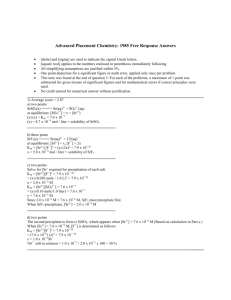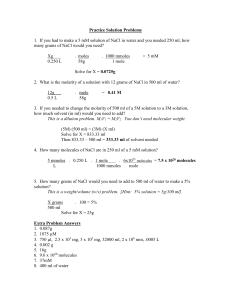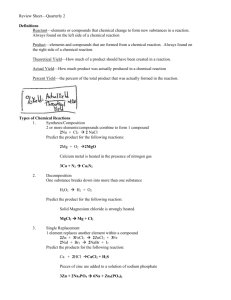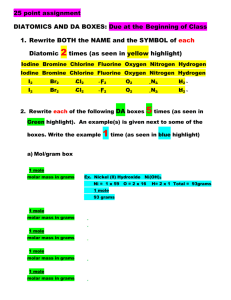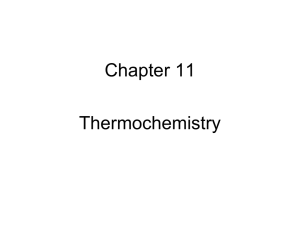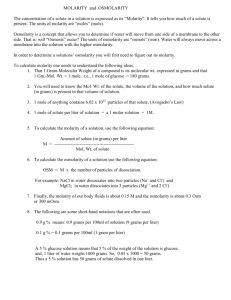1985
advertisement
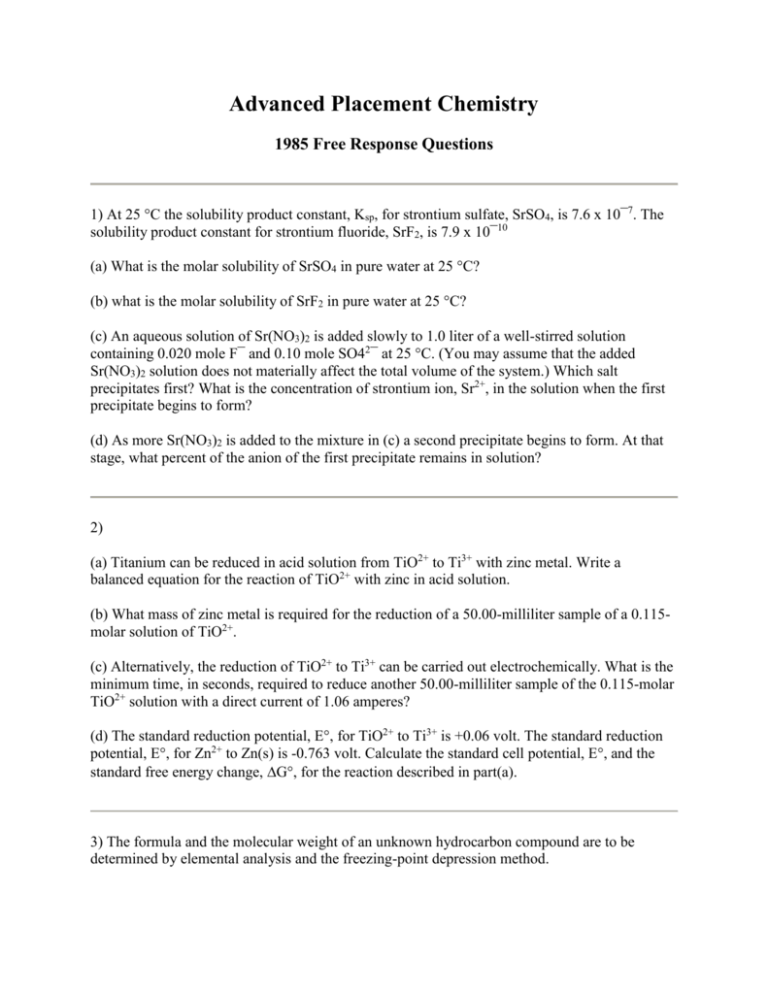
Advanced Placement Chemistry 1985 Free Response Questions 1) At 25 °C the solubility product constant, Ksp, for strontium sulfate, SrSO4, is 7.6 x 10¯7. The solubility product constant for strontium fluoride, SrF2, is 7.9 x 10¯10 (a) What is the molar solubility of SrSO4 in pure water at 25 °C? (b) what is the molar solubility of SrF2 in pure water at 25 °C? (c) An aqueous solution of Sr(NO3)2 is added slowly to 1.0 liter of a well-stirred solution containing 0.020 mole F¯ and 0.10 mole SO42¯ at 25 °C. (You may assume that the added Sr(NO3)2 solution does not materially affect the total volume of the system.) Which salt precipitates first? What is the concentration of strontium ion, Sr2+, in the solution when the first precipitate begins to form? (d) As more Sr(NO3)2 is added to the mixture in (c) a second precipitate begins to form. At that stage, what percent of the anion of the first precipitate remains in solution? 2) (a) Titanium can be reduced in acid solution from TiO2+ to Ti3+ with zinc metal. Write a balanced equation for the reaction of TiO2+ with zinc in acid solution. (b) What mass of zinc metal is required for the reduction of a 50.00-milliliter sample of a 0.115molar solution of TiO2+. (c) Alternatively, the reduction of TiO2+ to Ti3+ can be carried out electrochemically. What is the minimum time, in seconds, required to reduce another 50.00-milliliter sample of the 0.115-molar TiO2+ solution with a direct current of 1.06 amperes? (d) The standard reduction potential, E°, for TiO2+ to Ti3+ is +0.06 volt. The standard reduction potential, E°, for Zn2+ to Zn(s) is -0.763 volt. Calculate the standard cell potential, E°, and the standard free energy change, G°, for the reaction described in part(a). 3) The formula and the molecular weight of an unknown hydrocarbon compound are to be determined by elemental analysis and the freezing-point depression method. (a) The hydrocarbon is found to contain 93.46 percent carbon and 6.54 percent hydrogen. Calculate the empirical formula of the unknown hydrocarbon. (b) A solution is prepared by dissolving 2.53 grams of p-dichlorobenzene (molecular weight 147.0) in 25.86 grams of naphthalene (molecular weight 128.2). Calculate the molality of the pdichlorobenzene solution. (c) The freezing point of pure naphthalene is determined to be 80.2 °C. The solution prepared in (b) is found to have an initial freezing point of 75.7 °C. Calculate the molal freezing-point depression constant of naphthalene. (d) A solution of 2.43 grams of the unknown hydrocarbon dissolved in 26.7 grams of naphthalene is found to freeze initially at 76.2 °C. Calculate the apparent molecular weight of the unknown hydrocarbon on the basis of the freezing-point depression experiment above. (e)What is the molecular formula of the unknown hydrocarbon? 4) Use appropriate ionic and molecular formulas to show the reactants and the products for the following, each of which occurs in aqueous solution except as indicated.Omit formulas for any ionic or molecular species that do not take part in the reaction. You need not balance. In all cases a reaction occurs. (a) Sodium metal is added to water. (b) Dilute sulfuric acid is added to a solution of lithium hydrogen carbonate. (c) Ethanol and formic acid (methanoic acid) are mixed and warmed. (d) Excess concentrated potassium hydroxide solution is added to a precipitate of zinc hydroxide. (e) The gases boron trifluoride and ammonia are mixed. (f) A solution of tin(II) chloride is added to a solution of iron(III) sulfite. (g) Phosphorus(V) oxytrichloride is added to water. (h) An acidified solution of sodium permanganate is added to a solution of sodium sulfite. 5) Properties of the chemical elements often show regular variations with respect to their positions in the periodic table. (a) Describe the general trend in acid-base character of the oxides of the elements in the third period (Na to Ar). Give examples of one acidic oxide and one basic oxide and show with equations how these oxides react with water. (b) How does the oxidizing strength of the halogen elements vary down the group? Account for this trend. (c) How does the reducing strength of the alkali metals vary down the group? Account for this trend. 6) (a) When liquid water is introduced into an evacuated vessel at 25 °C, some of the water vaporizes. Predict how the enthalpy, entropy, free energy, and temperature change in the system during this process. Explain the basis for each of your predictions. (b) When a large amount of ammonium chloride is added to water at 25 °C, some of it dissolves and the temperature of the system decrease. Predict how the enthalpy, entropy, and free energy change in the system during this process. Explain the basis for each of your predictions. (c) If the temperature of the aqueous ammonium chloride system in part (b) were to be increased to 30 °C, predict how the solubility of the ammonium chloride would be affected. Explain the basis for your prediction. 7) Describe a separate laboratory procedure for preparing each of the following. (a) Pure barium sulfate from an aqueous solution of barium chloride. (b) A pure aqueous solution of copper(II) nitrate from solid copper(II) carbonate. (c) A pure aqueous solution of calcium chloride from an aqueous solution of calcium bromide. 8) PCl3(g) + Cl2(g) <===> PCl5(g) In the equation above, the forward reaction is first order in both PCl5 and Cl2 and the reverse reaction is first order in PCl5 (a) Suppose that 2 moles of PCl3 and 1 mole of Cl2 are mixed in a closed container at constant temperature. Draw a graph that shows how the concentrations of PCl3, Cl2, and PCl5 change with time until after equilibrium has been firmly established. (b) Give the initial rate law for the forward reaction. (c) Provide a molecular explanation for the dependence of the rate of the forward reaction on the concentrations of the reactants. (d) Provide a molecular explanation for the dependence of the rate of the forward reaction on temperature. 9) Substance Melting Point, °C H2 -129 C3H8 -190 HF -92 CsI 621 LiF 870 SiC >2,000 (a) Discuss how the trend in the melting points of the substances tabulated above can be explained in terms of the types of attractive forces and/or bonds in these substances. (b) For any pairs of substances that have the same kind(s) of attractive forces and/or bonds, discuss the factors that cause variation in the strengths of the forces and/or bonds. Advanced Placement Chemistry 1985 Free Response Answers Notes [delta] and [sigma] are used to indicate the capital Greek letters. [square root] applies to the numbers enclosed in parenthesis immediately following All simplifying assumptions are justified within 5%. One point deduction for a significant figure or math error, applied only once per problem. This note was found at the end of question 3: For each of the problems, a maximum of 1 point was subtracted for gross misuse of significant figures and for mathamatical errors if correct principles were used. No credit earned for numerical answer without justification. 1) Average score = 2.87 a) two points SrSO4(s) <===> Sr(aq)2+ + SO42¯(aq) at equilibrium: [SO42¯] = x = [Sr2+] (x) (x) = Ksp = 7.6 x 10¯7 (x) = 8.7 x 10¯4 mol / liter = solubility of SrSO4 b) three ponts SrF2(s) <===> Sr(aq)2+ + 2 F(aq)¯ at equilibrium: [Sr2+] = x, [F¯] = 2x Ksp = [Sr2+] [F¯]2 = (x) (2x)2 = 7.9 x 10¯10 x = 5.8 x 10¯4 mol / liter = solubility of SrF2 c) two points Solve for [Sr+ required for precipitation of each salt. Ksp = [Sr2+][F¯]2 = 7.9 x 10 ¯10 = (x) (0.020 mole / 1.0 L)2 = 7.9 x 10¯10 x = 2.0 x 10¯6 M Ksp = [Sr2+][SO42¯] = 7.6 x 10¯7 = (y) (0.10 mole/1.0 liter) = 7.6 x 10¯7 y = 7.6 x 10¯6 M Since 2.0 x 10¯6 M < 7.6 x 10¯6 M, SrF2 must precipitate first. When SrF2 precipitates, [Sr2+] = 2.0 x 10¯6 M d) two points The second precipitate to form is SrSO4, which appears when [Sr2+] = 7.6 x 10¯6 M (Based on calculation in Part c.) When [Sr2+] = 7.6 x 10¯6 M, [F¯] is determined as follows: Ksp = [Sr2+][F¯]2 = 7.9 x 10¯10 = (7.6 x 10¯6) (z)2 = 7.9 x 10 ¯10 z = 1.0 x 10¯2M %F¯ still in solution = 1.0 x 10¯2 / 2.0 x 10¯2 x 100 = 50.% 2) Average score = 4.91 a) one point Zn ---> Zn2+ + 2e¯ 2 TiO2+ + 4H+ + 2e¯ ---> 2 Ti3+ + H2O The sum of the equations above is: 2 TiO2+ + 4H¯ + Zn ---> Zn2+ + 2Ti3+ + H2O b) 3 points; one for each term in solution (0.0500 liter x 0.115 mole TiO2+ / 1 liter) x (1 mole Zn / 2 mole TiO2+) x (65.4 grams Zn / 1 mole Zn) = 0.188 gram Zn c) two points 0.500 liter x (0.115 mole TiO2+ / 1 liter) x (1mole e¯ / 1 mole TiO2+) x (96.500coulombs / 1 mole e¯) x (1 amp-sec / 1 coulomb) x (1 / 1.06 amp) = 523 sec d) two points Zn ---> Zn2+ + 2e¯ 2 TiO2+ + 4 H++ 2e¯ ---> 2 Ti3++ 2 H20 E° = 0.763 V E° = 0.060V E° for total reaction: 0.763V + 0.060V = 0.823 V [delta]G° = -nFE° = - (2 mole e¯) (96.500 coulombs / 1 mole electrons) (0.823 / 1mole) (1 joule/1 V-coul) = - 1.59 x 105 J 3) Average score = 5.15 a) two points Assume a 100-gram sample of hydrocarbon 93.46 grams C x (1 mole C / 12.01 grams C) = 7.782 moles C 6.54 grams H x (1 mole H / 1.008 grams H) = 6.49 moles H 7.782 moles C / 6.49 moles H = 1.20 C1.20H1.00 = C6H5 b) two points Molality = moles solute per kilogram solvent m = (2.53 grams solute / 25.86 grams solute) x (1 mole solute / 147.0 grams solute) x (1000 grams solute / 1 kg solvent) = 0.665 m c) one point Freezing point lowering = 80.2° - 75.7° = 4.5° Molal freezing point depression constant = (4.5° / 0.665 molal solution) = 6.8° lowering for 1 molal solution d) three points Freezing point lowering = 80.2° - 76.2° = 4.0° (6.8 x kg. solvent/mole solute) x (1 / 4.0°) x (2.43 grams solute / 26.7 grams solvent) x (1000 grams solvent / kg solvent) = 154 grams solute / mole solute) e) one point Empirical unit weight (C6H5) = 77 Number of empirical units per mole= 154 / 77 = 2 molecular formula = (C6H5) x 2 = C12H10 4) Average score = 4.05 Credit: 1 point for each set of reactants, 2 points for products. (If two products, 1 point for each product.) a) Na + H2O ---> Na+ + OH¯ + H2 b) H+ + HCO3¯ ---> H2O + CO2 (Part credit for H2CO3) c) C2H5OH + HCOOH ---> HCOOC2H5 + H2O d) OH¯+ Zn(OH)2 ---> Zn(OH)42¯ (or Zn(OH)3¯ or ZnO22¯ + H2O) e) BF3 + NH3 ---> BF3NH3 f) Sn2+ + Fe3+ ---> Sn4+ + Fe2+ g) POCl3 + H2O ---> H3PO4 + H+ + Cl¯ h) MnO4¯ + SO32¯ + H+ ---> Mn2+ + SO42¯ + H2O HSO3¯ and HSO4¯ were accepted. (Part credit if H+ and H2O were omitted) 5) Average score = 3.43 a) three points Oxides at left are basic and become less basic: more acidic as one moves to the right. Basic oxide: Na2O + 2 H2O ---> 2 Na+ + 2 OH¯ or MgO + H2O ---> Mg(OH)2 Acidic oxide: any one of the oxides of Cl, S, or P SO2+ H2O ---> H2SO3 or equivalent for another oxide (Both examples with no equations 1 point) b) two points Oxidizing strengths of halogen elements decrease down the group. Since atoms get larger down the group, the attraction for e¯ decreases and oxidizing strength increases c) two points Reducing strengths of alkali metals increases down the group. Since atoms get larger down the group, loss of outer electrons is easier and reducing strength increases. 6) Average score = 3.34 a) four points [delta]H > 0 since heat is required to change liquid water to vapor. [delta]S > 0 since randomness increases when a liquid changes to vapor. [delta]G < 0 since the evaporation takes place in this situation. [delta]T < 0 since the more rapidly moving molecules leave liquid first. The liquid remaing is cooler. b) three points [delta]H > 0. The system after the dissolving has a lower temperature and so the change is endothermic. [delta]S > 0. Since the solution is less ordered than the separate substances are. [delta]G < 0. The solution occured and so is spontaneous. c) one point Solubility increases. The added heat available pushes the endothermic process toward more dissolving. Note: Both direction of change and explanation were required for full credit. If explanations for a variable were correct but the directions of change were wrong, credit was granted only once for that variable. 7) Average score = 2.36 a) three points Precipitation of insoluble BaSO4 by adding a solution of a soluble sulfate, e.g., Na2SO4 Isolate BaSO4 by filtration Purify BaSO4 by washing and drying it b) three points Dissolve copper(II) carbonate with nitric acid to form copper (II) nitrate solution Isolate by avoiding the addition of excess acid Purify by heating to drive off CO2 c) two points Form CaCl2 solution by treating CaBr2solution with Cl2. Or add a soluble carbonate. Separate the precipitated CaCO3, wash, and dissolve it in HCl. Purify CaCl2solution by extracting the Br2 with CH2Cl2or equivalent. Or heat the solution. 8) Average score = 3.52 a) thre points Points on ordinate take into account the initial amounts of the three substances, and PCl5 line rises while others fall. Lines curved at start and flat after equilibrium. Concentration changes should be consistant with the fact that all coefficients in the equation are unity. b) two points - First order in both reactants, Inclusion of constant Rate = k [PCl3] [Cl2] c) one point Reaction requires effective collisions between molecules of PCl3 and Cl2 As concentrations of these molecules increase, the number of effective collisions must increase and the rate of action increases. d) two points The fraction of colliding molecules with the required activation evergy increases as the temperature rises. 9) Average score = 2.95 a) six points H2 and C3H2 have low melting points because the forces involved are the weak van der Waals (or London) forces. HF has a higher melting point because intermolecular hydrogen bonding is important. CsI and LiF have still higher melting points because ionic lattice forces must be overcome to break up the crystals, and the ionic forces are stronger than van der Waals forces and hydrogen bonds. SiC is an example of a macromolecular substance where each atom is held to its neighbors by a very strong covalent bond. b) two points C3H8and H2: There are more interactions per molecule in C3H8than in H2. Or C3H8 is weakly polar and H2 is nonpolar. LiF and CsI: The smaller ions in LiF result in a higher lattice energy than CsI has. Lattice energy U is proportional to 1 / (r+ + r¯)
